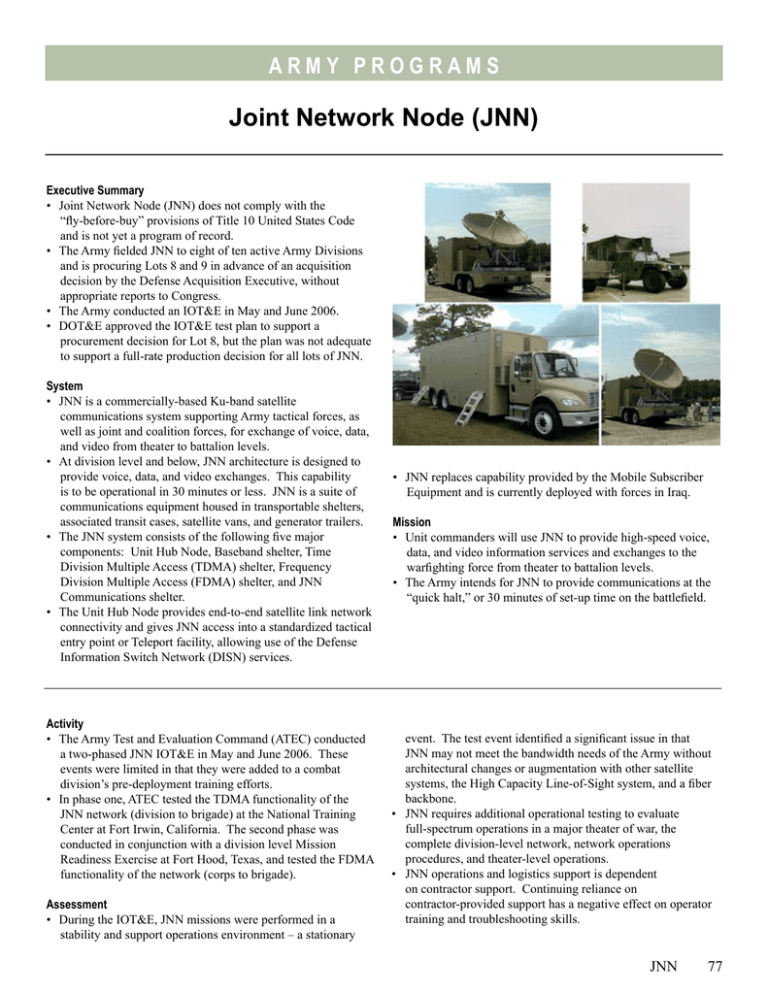Joint Network Node (JNN) Program Analysis & Recommendations
advertisement

A r my P RO G R A M S Joint Network Node (JNN) Executive Summary • Joint Network Node (JNN) does not comply with the “fly-before-buy” provisions of Title 10 United States Code and is not yet a program of record. • The Army fielded JNN to eight of ten active Army Divisions and is procuring Lots 8 and 9 in advance of an acquisition decision by the Defense Acquisition Executive, without appropriate reports to Congress. • The Army conducted an IOT&E in May and June 2006. • DOT&E approved the IOT&E test plan to support a procurement decision for Lot 8, but the plan was not adequate to support a full-rate production decision for all lots of JNN. System • JNN is a commercially-based Ku-band satellite communications system supporting Army tactical forces, as well as joint and coalition forces, for exchange of voice, data, and video from theater to battalion levels. • At division level and below, JNN architecture is designed to provide voice, data, and video exchanges. This capability is to be operational in 30 minutes or less. JNN is a suite of communications equipment housed in transportable shelters, associated transit cases, satellite vans, and generator trailers. • The JNN system consists of the following five major components: Unit Hub Node, Baseband shelter, Time Division Multiple Access (TDMA) shelter, Frequency Division Multiple Access (FDMA) shelter, and JNN Communications shelter. • The Unit Hub Node provides end-to-end satellite link network connectivity and gives JNN access into a standardized tactical entry point or Teleport facility, allowing use of the Defense Information Switch Network (DISN) services. Activity • The Army Test and Evaluation Command (ATEC) conducted a two-phased JNN IOT&E in May and June 2006. These events were limited in that they were added to a combat division’s pre-deployment training efforts. • In phase one, ATEC tested the TDMA functionality of the JNN network (division to brigade) at the National Training Center at Fort Irwin, California. The second phase was conducted in conjunction with a division level Mission Readiness Exercise at Fort Hood, Texas, and tested the FDMA functionality of the network (corps to brigade). Assessment • During the IOT&E, JNN missions were performed in a stability and support operations environment – a stationary • JNN replaces capability provided by the Mobile Subscriber Equipment and is currently deployed with forces in Iraq. Mission • Unit commanders will use JNN to provide high-speed voice, data, and video information services and exchanges to the warfighting force from theater to battalion levels. • The Army intends for JNN to provide communications at the “quick halt,” or 30 minutes of set-up time on the battlefield. event. The test event identified a significant issue in that JNN may not meet the bandwidth needs of the Army without architectural changes or augmentation with other satellite systems, the High Capacity Line-of-Sight system, and a fiber backbone. • JNN requires additional operational testing to evaluate full-spectrum operations in a major theater of war, the complete division-level network, network operations procedures, and theater-level operations. • JNN operations and logistics support is dependent on contractor support. Continuing reliance on contractor-provided support has a negative effect on operator training and troubleshooting skills. JNN 77 A r my P RO G R A M S • Significant difficulties were encountered in collecting and reducing the data during the test. The difficulties indicate that development of measures, instrumentation, and data reduction techniques are needed to test large, high-speed data networks where the network nodes, as well as subscribers, are on the move. • DOT&E approved the IOT&E test plan to support a procurement decision for Lot 8, but the plan was not adequate to support a full-rate production decision for all lots of JNN. • JNN has an approved joint capabilities document, but does not have an approved acquisition strategy or an approved Test and Evaluation Master Plan. The Army awarded sole source procurements for JNN Lots 8 and 9 prior to establishing a program of record. 78 JNN • JNN does not comply with the “fly-before-buy” provisions of Title 10 United States Code. Recommendations • Status of Previous Recommendations. No FY05 report was submitted on JNN. • FY06 Recommendations. The Army should: 1. Develop an acquisition strategy, concept of operations, and test strategy for the transition from JNN to Warfighter Information Network-Tactical. 2. Establish JNN as a formal Program of Record with appropriate documentation. 3. Conduct adequate operational testing for future lots of JNN.







